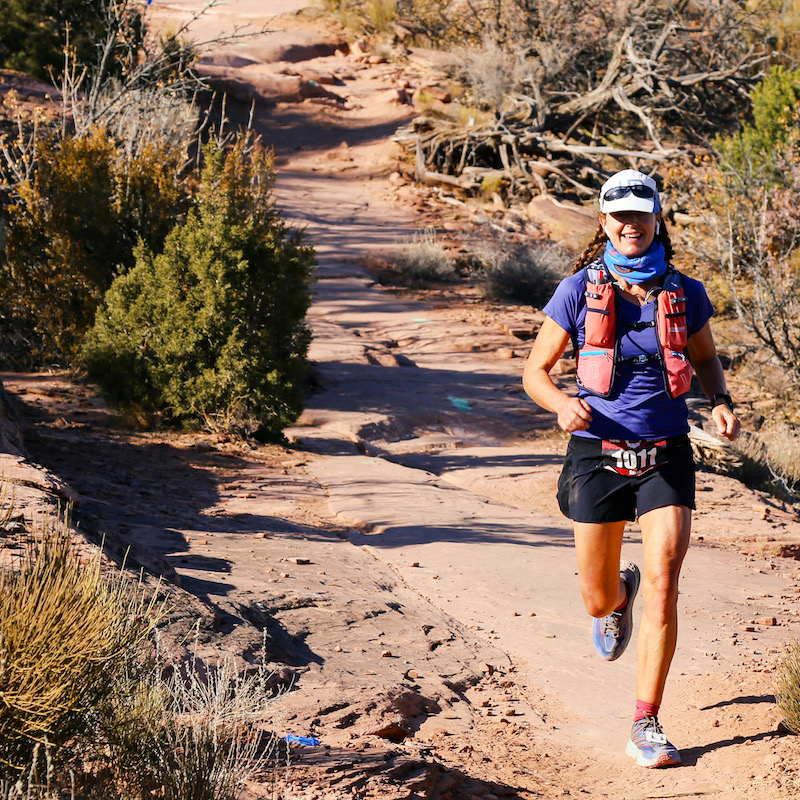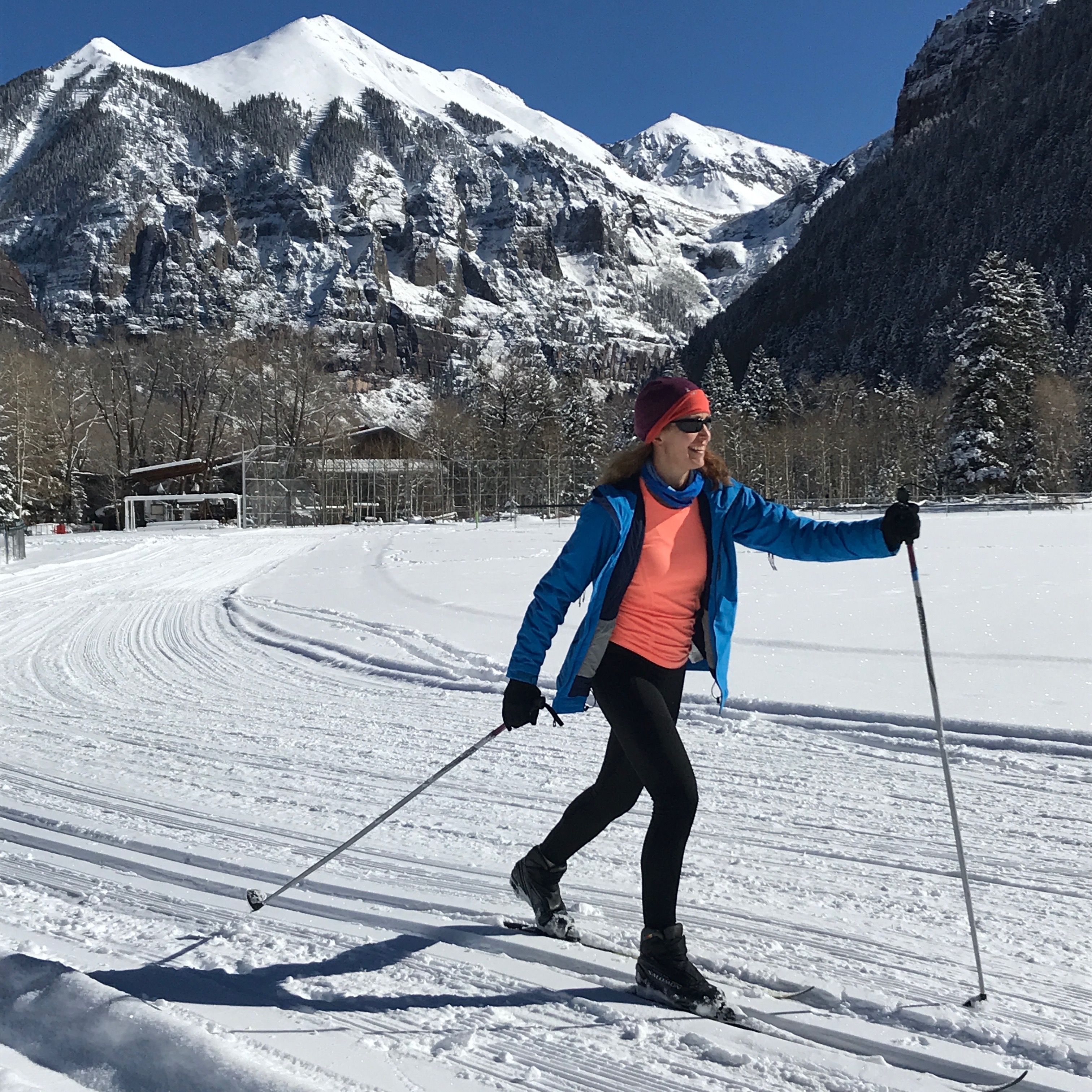On my Thanksgiving morning run, I alternated between feeling nostalgic that I’m no longer in Piedmont, California, for the annual Turkey Trot 5K, and grateful that I faced no self-imposed pressure to race fast. I flashed back on all the years I raced the Turkey Trot trying to keep my time under 20 minutes, burning with the stress of effort while chasing young adults half my age, and I felt liberated because now I’m enjoying time off from structured, goal-oriented running.
It felt lovely to run steadily and solo on the town’s flat bike path for three miles, then alternately hike and run three more miles up the snow- and ice-covered dirt road to our home. When I downshifted to hiking up the hill, I told myself, “Start running only if you feel like it,” and therefore, I hiked until impatience stirred, and only then did I break into a run for a short stretch. Pace and distance didn’t matter; feeling good did.
My last race happened two weeks earlier, the Moab Dead Horse 50K, and following it, I decided to take time off from training for about six weeks, from late November until the week of New Year’s. Then I will resume deliberate training with the goal of preparing for upcoming spring and summer races.
But what does “an off period” or “a break from training” look like? Does it mean giving up running completely? Not necessarily; it can mean taking a different approach to it, which is what I’m presently doing.
Clearly many runners wonder or struggle with how little or much to train during these winter months, if the December issue of UltraRunning magazine is any indication; the issue is full of advice related to off-seasons and winter training.
Prompted in part by a friend who messaged me asking for advice on winter running and training, I decided to share what I do and advise.

Last race of the year, before taking a break from training: the Nov. 16 Moab Dead Horse 50K
1. Ask Yourself: Do You Need a Break from Training?
Decide whether and why, and for how long and how much, you want to reduce your running. Under the principle of periodization, training should wax and wane in the macrocycle of your year, meaning you should increase your training load carefully and progressively to stress your body, then layer in rest to adapt to that stress. If you have engaged in focused, structured training for most of the year, then you’ll benefit mentally and physically from giving yourself a break ranging from a couple of weeks to a couple of months before starting a new training block and building up your training load again.
For those of us living in a snowy climate, it makes sense to reduce training volume during these cold months with less daylight, because running outside is challenging and often unpleasant. Additionally, if you run in a place where temperatures dip into the single digits or lower, then you should move your high-intensity training indoors to avoid stressing your lungs; as this smart article details, prolonged high-intensity exercise in very cold temperatures increases your risk for exercise-induced bronchospasm.
If, however, you have a goal race early in the new year, such as the Way Too Cool 50K or Napa Marathon (both in early March), then brace yourself to train through the darker, wetter months of December through February—you should’ve taken time off in autumn instead.
Personally, I want to run less between Thanksgiving and Christmas for several reasons, including the frigid weather, more family time and a desire to ski. It feels refreshing to stop caring about weekly mileage totals and to run by feel for a while; it means that when I refocus on training for spring races, I’m more likely to feel in “comeback mode,” eager to rebuild running-specific fitness.
2. Reduce, Don’t Eliminate, Running; Maintain Your Base
Following a depleting race, I advise a “reverse taper”—one to three weeks of reduced running, depending on the distance and depletion of the race, that looks like the inverse of the taper period that led to the race. If you want to continue this reverse taper with an “off” period for added recovery, then keep your running minimal, but don’t give it up entirely.
I advise against completely taking time off from running beyond the week following a tough race, except in case of illness or injury, because chances are you’ll feel worse psychologically and physically, rather than better, if you fall out of your running routine. Plus, it’s harder to restart a training cycle for running if you haven’t been running at all; you’ll feel awkward and achy until your body adapts again to running frequently.
To reduce your running and to feel rejuvenated without suspending it completely, de-emphasize distance and pace; instead of feeling as if you “should” run longer on the weekend, or you “should” do a weekly speed workout, ask yourself, “What do I feel like running today?” Run by feel and reassure yourself that sometimes, “less is more” and “some is better than none.” If you want to take more walking breaks and hike all the uphills, go ahead and do that.
But, try to avoid more than two days off between runs. If you normally run five to six days a week, then consider scaling back to three or four times a week. Personally, during my “off” season, I typically run four times a week, and my weekly mileage totals in the mid-20s to low 30s, about 50% of normal volume. If I feel like a hard workout, then I’ll put extra effort into a gym workout followed by a higher-intensity run indoors on the treadmill. I keep my outdoor winter running mellow because of the cold temperature and the slippery, sloppy terrain.
3. Explore Cross Training
Your off period is prime time to have fun with other sports and different workouts. Challenging your body in new ways helps maintain your fitness while also developing skills and strength that can benefit your running longer term. If you discover you like the cross training, then try to fit it in during the earlier phases of your upcoming training cycle until higher-volume, more-specific training during the peak phase takes priority over time spent cross training.
I’ve become devoted to a twice-weekly indoor boot-camp type of fitness class that builds cardio and strength through high-intensity interval training. (I normally do an easy-pace 3 or 4 mile run before or after the class.) I love this class because the supportive group environment gets me to do a greater variety of exercises, and more of them, than I’d do on my own. Every class is different, and I like being told what to do once in a while. I’m convinced that this class helped my performance in recent ultras—such as when I had to carry a pack in the Grand to Grand Ultra, or had to navigate uneven, undulating slickrock at the Moab 50K—by developing core and lower-body strength plus agility.
I’m also taking up Nordic and downhill skiing, and I’m riding my horse (although only once a week, since he’s in winter boarding in the milder climate of Montrose, which is more than an hour away). All this activity means less time available for running, but that’s fine for now.

During boot camp class at Telluride FUEL gym, I do exercises I probably wouldn’t do on my own, such as boxing while steadying the punching bag with my feet to work both core and arms.
4. Make Friends With a Treadmill
Many runners I know loathe the treadmill because of the monotony, or because they feel they can’t get a quality workout on it. I liken it to how I hated swimming and felt bored in the pool after 10 minutes until someone explained how to swim laps in a more purposeful and structured way. I admit, I have a hard time lasting on a treadmill longer than an hour; but, that hour can be highly worthwhile, be it an intentional easy run or a harder workout. Here are a handful of treadmill tips:
- Combine the treadmill with another workout or run. For example, if you go to the gym for strength work, then run two to three miles on the treadmill first as a warmup (you’ll find it makes your conditioning workout better).
- Combine a treadmill run with outdoor running. Head outside in the winter weather for a mellow-pace half hour to warm up. Then go inside, head straight to the treadmill, and do another half hour or longer at a faster, steadier pace.
- Vary the elevation profile on the treadmill and have fun making up a pattern. For example, you can get a quality 5-mile hill workout simulating rolling and then steep vert with the following: 1 mile easy pace at 1% incline; .5 mile at 3% incline at a “comfortably hard” intensity, with breathing elevated to the point where your ability to talk is limited to short phrases, followed by .5 mile at 1% incline and easy pace for recovery. Next two miles: increase the incline by an additional one percent for a half mile, followed by a half mile at easy pace and 1% incline. Final mile: increase the incline to its highest level (on many treadmills this is 15%) and practice powerhiking at approx 3mph (20 min/mile) for at least a half mile. Try holding 5- or 8-pound weights in each hand for added resistance. Finish with a half mile or so of easy running. If you feel like it, throw in a set of strides (surging toward sprint for 30 seconds) during this final portion of your run, to promote good form and turnover.
- Break up your treadmill session with speed intervals, accelerating to close to max effort. I like a descending ladder workout, such as 5, 4, 3, 2, 1-minute fast intervals with 2 minutes slow running for recovery between each. Or you can do a simple pattern of on/offs such as 3 minutes fast, 2 minutes easy. The idea is to make the treadmill time more interesting and satisfying by breaking up the workout and varying your pace and effort level.
- When all else fails, watch a movie or listen to an audiobook or podcast. Treadmill time can be good for catching up on media while running a relaxed pace!
5. Organize Your Upcoming Training Blocks
Use this time to contemplate and organize your upcoming goals and the time frames to train for them. The new calendar year, along with ultra lotteries, makes December a natural time to figure out what you want to do and achieve athletically in the coming months. Getting a few races on calendar helps structure and motivate your training. Decide if the race is an “A” goal or a training race for a goal later in the season.
I deliberately decided to sign up for some early-season races as part of my new year’s training, rather than as stand-alone goals. Only one race feels serious and goal-oriented for me: the High Lonesome 100 in late July. I want to finish this 100-miler successfully and with confidence, having suffered through prior mountain 100s and just barely finishing them. All other races in the first half of the year (see “My Race Calendar” sidebar for details) are intended to aid the buildup toward the High Lonesome 100 and will be more for fun and self-improvement—for the training, the destination and the camaraderie—than for competition. Even the Mauna to Mauna Ultra in May—an extremely challenging self-supported stage race—will be more a “vacation” and celebratory experience than a competitive test; I’m going because I won it as a prize, I look forward to experiencing Hawaii again, and I want the early-summer boost it’ll give my endurance and fitness.
Starting the week of December 30, I’ll resume training aimed at enhancing endurance and practicing the specifics of my first race on the calendar, the February 21 Running Up for Air 12-hour event in Salt Lake City, which features a 3-mile high-altitude hike/run up a snow- and ice-covered singletrack trail to a peak, then a run back down, repeatedly in the 12-hour time frame. During the weeks in January and February, I’ll alternate that kind of rugged hiking/running up and down vert on snowy terrain a few days a week with faster steady running on the treadmill or the flat bike path to tune up my legs and lungs for the back-to-back challenges of the Lake Sonoma 50 and Boston Marathon in April.
6. Clean Up Your Nutrition and Gradually Work Toward Optimal Weight
For various reasons—cooking for the holidays, wearing extra layers for the cold weather, feeling a desire to cut loose and indulge in a surfeit of good food and drink—I tend to put on weight this time of year. After a couple of less-healthy, over-indulgent weeks, I’ll restart practicing what I preach, which is: Use an off season to achieve healthy eating and adequate sleep for all-over wellness.
A sports nutritionist, Meredith Terranova, once told me, “Get to your optimal weight now, rather than struggling and waiting toward the end of the training cycle, and it will make your whole training go so much better.” In other words, don’t pack on pounds now in anticipation of getting back in shape later through running; rather, work toward healthy weight through good nutrition sooner rather than later so that your upcoming training cycle will feel even better with greater fitness. Too many runners fight their weight during their training—which sets up an adversarial relationship with food, rather than properly viewing food as your fuel and your friend—and then, they restrict calories during the taper before a race, sabotaging race-day performance. Avoid this unhealthy scenario by achieving and maintaining healthy nutrition during the off season, using moderation and staying in touch with your body’s hunger and fullness cues. (More details in this past blog post.)
There you have it—guidelines to run a lot less now so that you can run and feel better in the new season.
p.s.
In case you missed it, I published my annual “gift guide” which is intended as much as a list of recommended gear, clothing and books for you, the mountain/ultra/trail runner and hiker, as it is for buying gifts. Check it out here.
On a more meaningful note, I wrote an in-depth profile of Nickademus and Jade de la Rosa. Nick (former last name Hollon) was at the top of ultrarunning, and in the rarified group of finishing and winning Barkley, before becoming sidelined two years ago with physical and mental illness. Jade, an up-and-coming ultrarunner, has been a rock of support through tough times. I’m grateful they trusted me with their story of love and endurance. I hope you’ll give it a read here.

Getting the hang of classic Nordic skiing for cross-training fun.

I hope you are going to do a blog on Dead Horse 50K you did. My son goes to college in SLC and I have been scoping out races to do in Utah and this one interested me after hiking there in October. I live in VT so altitude adjusting is an issue for me, not while hiking but definitely running!
hi Lisa, thanks for reading & commenting! I don’t plan to do a race report on that 50K, because it wasn’t very eventful and now several weeks have passed. But, I do recommend the event. The route is not too difficult; much of it is wide dirt road, not very technical, and the climbs are not too challenging, so most of the course is runnable. The biggest challenge is the portions of undulating slickrock that takes agility and concentration to navigate. It’s a lovely area, and Mad Moose puts on a good operation. It is a big ultra however in terms of numbers of participants, so you’ll likely be running with a lot of others rather than experiencing solitude, and some of the route is along a jeep road so several off-road vehicles pass, which can be annoying. But I still recommend it. Good luck with your training. By the way, my book has a section on preparing for altitude while living at sea level, which you may find helpful.